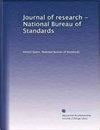Range-Programming Stripping Voltammetry for Determination of Some Metals in Seawater
Journal of research of the National Bureau of Standards
Pub Date : 1988-05-01
DOI:10.6028/jres.093.051
引用次数: 0
Abstract
Multielement capability of stripping analysis is one of its distinctive advantages described elsewhere [I]. Anodic stripping voltammetry with the use of differential pulse mode (DPASV) is uniquely suited [2], and therefore, applied extensively to the direct simultaneous determination of some trace metals (Zn, Cd, Pb, and Cu) in sea waters [3,4]. Even with the well-established procedure for a given sample, there still arises the problem introduced by simultaneously measuring relative concentrations of metal ions. A case in point is zinc and cadmium concentrations whose ratio sometimes is as high as 400 (12 ppb Zn/0.03 ppb Cd), and typically as high as 200 in raw surface sea waters [3]. In such a case, either one must run the entire steps separately by selecting suitable variables for each metal or pair of metals whose concentration ratio is adequate for simultaneous measurement, or the recorder scale must be changed during a single run to obtain the best results. The latter approach, difficult to achieve manually in practice, would rely on the application of an autoranging amplifier [5]. The use of an autoranging amplifier, however, has given rise to complications in evaluating the resulting voltammograms in most practical applications for analyzing seawaters [6]. The present work was initiated in order to overcome deterioration in readability and data quality, by developing a new programmedranging technique.程式化溶出伏安法测定海水中某些金属
剥离分析的多元素能力是其在其他地方描述的独特优势之一[1]。差分脉冲模式阳极溶出伏安法(DPASV)特别适用于[2],因此广泛应用于海水中某些微量金属(Zn、Cd、Pb和Cu)的直接同时测定[3,4]。即使对给定的样品有了完善的程序,在同时测量金属离子的相对浓度时仍然会出现问题。一个典型的例子是锌和镉的浓度,其比例有时高达400 (12 ppb Zn/0.03 ppb Cd),在原始表层海水中通常高达200。在这种情况下,要么必须单独运行整个步骤,为每种金属或对金属选择合适的变量,其浓度比足以同时测量,要么必须在单次运行期间更换记录仪刻度,以获得最佳结果。后一种方法,在实践中难以手动实现,将依赖于一个自动量程放大器[5]的应用。然而,在分析海水[6]的大多数实际应用中,使用自动量程放大器在评估产生的伏安图时引起了复杂性。目前的工作是为了通过开发一种新的程序编制技术来克服可读性和数据质量的恶化。
本文章由计算机程序翻译,如有差异,请以英文原文为准。
求助全文
约1分钟内获得全文
求助全文

 求助内容:
求助内容: 应助结果提醒方式:
应助结果提醒方式:


